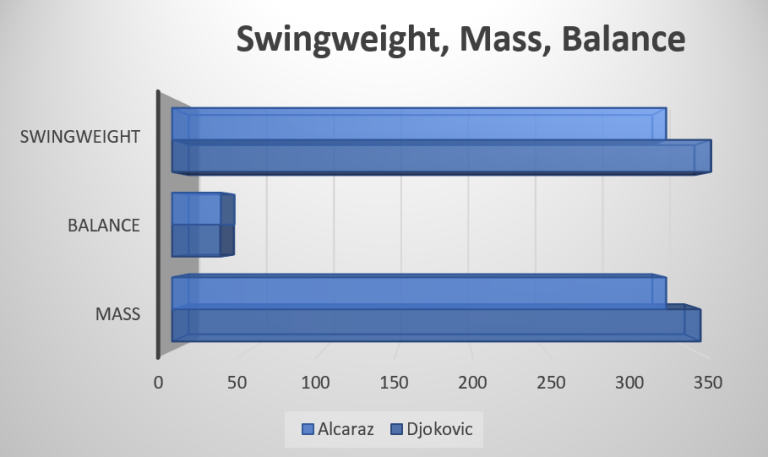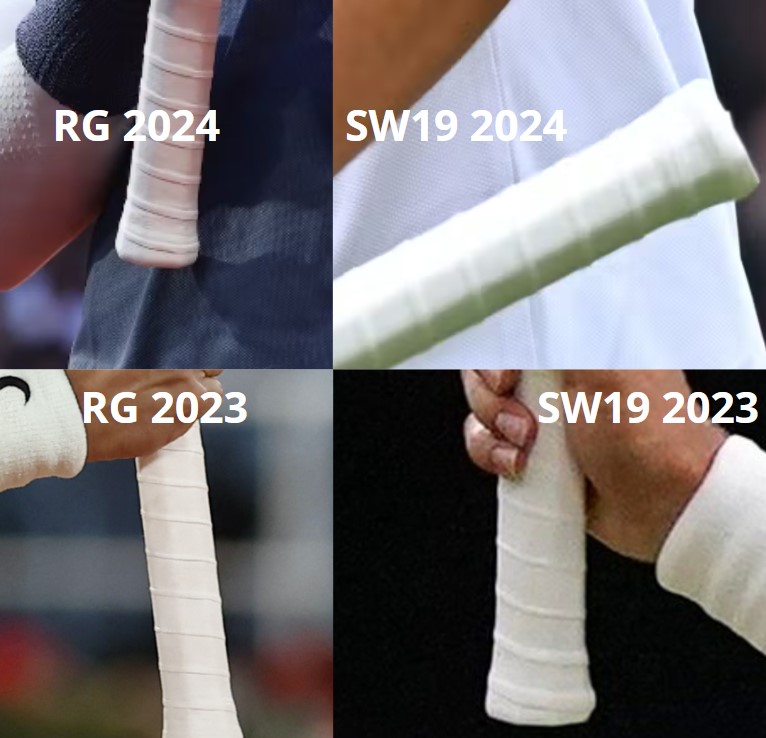Introduction
As the pristine lawns of Wimbledon prepare for the 2024 Men’s Singles Finals, we find ourselves in a familiar scenario. Novak Djokovic and Carlos Alcaraz, the same competitors from last year’s epic final, are set to clash once again. While the matchup remains largely unchanged, there are new observations to be made, especially regarding Alcaraz’s adaptation to grass last year and this year. Both players have fine-tuned their strategies and equipment to optimize their performance on this fast surface. Here’s an in-depth analysis of how their racket setups will influence the dynamics of this high-stakes encounter.
Yet, the match isn’t merely a clash of talent, experience, and grit; it’s also a showcase of meticulously tailored equipment choices. The tools of the trade, the tennis rackets, are customized to match the unique playing styles of the athletes and could play a crucial role in this high-stakes encounter.
Matchup Analysis
Djokovic: Mastery of Control and Stability
Djokovic’s racket, the Head Speed Pro (PT113B underneath), is optimized for control and stability. The heavier weight and high swingweight provide exceptional stability, crucial for absorbing and redirecting Alcaraz’s powerful shots. The dense 18×19 string pattern offers precision, enabling Djokovic to place his shots with surgical accuracy, essential on the fast grass courts where margins are slim.
Alcaraz: Harnessing Power and Speed
Alcaraz, on the other hand, relies on the Babolat Aero 98, a racket designed for explosive power and quick maneuverability. The slightly lighter weight and open string pattern enhance his ability to generate spin and pace. Alcaraz’s aggressive baseline game is supported by the Aero’s aerodynamic frame, allowing him to unleash rapid, heavy shots that can keep Djokovic on the defensive.

Tactical Adjustments and Strategic Insights
Adapting to Grass: Alcaraz’s Growth
Over the past two years, Alcaraz has shown remarkable improvement on grass. His ability to adjust his footwork and shot selection to suit the low-bounce, fast-paced surface has been impressive. The Babolat Aero’s maneuverability aids in his quick adjustments and aggressive play, enabling him to take control of rallies with powerful forehands and sharp angles.
Last year, Alcaraz also adapted how he wrapped his overgrip for grass court play. He wrapped it a lot closer together at the beginning, giving him a bigger grip/buttcap, making the racket more stable in his hand, especially on shorter swings, but limiting the racket ceiling. This year it seems the wrapping is about the same as it was for the clay season. Have a look at the pictures below:

Perhaps this adjustment last year threw him off too much for the remainder of the season, and this year he is looking for consistency before going back to clay court for the Olympic Games tournament. Either way, it seems to me he needs to play with more spin and take longer strokes than last year, while last year he played more flat. Last year the strategy seemed to work out for him, but let’s see if he can make it work this year. It might be the slight difference that will turn the pendulum in Novak’s favour.
Djokovic’s Counterpunching Excellence
Djokovic’s game thrives on his ability to neutralize his opponent’s strengths and turn defense into offense. His racket’s stability allows him to handle Alcaraz’s aggressive shots with ease, redirecting them with precision. Djokovic’s exceptional movement and ability to anticipate Alcaraz’s patterns will be pivotal in sustaining long rallies and creating opportunities to exploit any weaknesses.
I suspect that Djokovic will be able to play with more efficiency, while Alcaraz will be exerting more energy to keep up with Novak, especially compared to last year when the adjustments that he made to the grip helped him to play closer to the baseline, take shorter strokes, and have a better return—all aspects that offer an advantage on grass.
The last time these two met at a Grand Slam event was last year’s final. Djokovic hasn’t played many top 10 opponents lately, especially the likes of Alcaraz and Sinner, so he wasn’t really tested, and his knee injury and surgery still put a big question mark on his fitness. Although he was a bit lucky by getting extra days to rest when De Minaur pulled out of the quarter-final match and then getting a straight 3:0 sets win in the semi-finals.
Alcaraz also had some issues with injury this year, specifically his forearm. This might also be the reason for not wrapping the racket the same way this year, as this would put more stress on his arm. At the moment, this injury doesn’t seem to bother him anymore, at least on the surface.
One also cannot discount the role of mental endurance and prowess. Alcaraz will be looking to defend a Grand Slam title for the first time, while Djokovic will be playing to cement himself at the top of all-time Grand Slam championships won and trying to tie Federer and Sampras at 8 Wimbledon titles. Both will feel like they belong at the center court in the finals, and both will be playing for their own piece of history in tennis.
Conclusion: A Clash of Titans
The Wimbledon 2024 Finals promise not only a captivating face-off between a seasoned champion and a rising star but also a fascinating showcase of tennis racket customization. The choices Djokovic and Alcaraz have made about their rackets reflect their individual strategies and their adaptability to various playing conditions. In a match where every shot and point counts, these racket configurations may indeed tip the balance and influence the outcome of this historic face-off.
As spectators, we get a unique insight into how these elite players utilize their equipment to bolster their game plans and adapt to the court’s demands. Regardless of the outcome, this match will undoubtedly contribute to the ongoing dialogue about the role of equipment customization in modern tennis.
Remember that this analysis is purely about the rackets; multiple other factors can sway the match’s outcome. However, understanding how a racket configuration influences a player’s strategy and performance is key in appreciating the nuanced, technical side of tennis.
Stay tuned as we eagerly await to see whose tennis racket customization will reign supreme on the grandest stage of Wimbledon 2024. In the meantime, if you’re interested in more insights into the racket specifications that top-tier players use, be sure to check our database. The saga of Djokovic vs. Alcaraz is just one of many narratives to explore in the fascinating world of tennis.